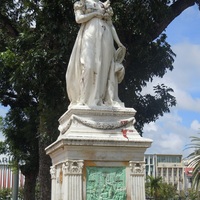How to cite this page Comment citer cette page
1859, inauguration of the statue of Empress Josephine, Place de la Savane
Event
- has description | a une description
-
The statue was inaugurated with great fanfare during three days of festivities in Fort-de-France on August 29, 30 and 31, 1859. The splendor of the ceremony was enhanced by the presence of many distinguished guests, first and foremost the Governor of Guadeloupe and members of that colony's administration, but also many foreigners. Representatives from several neighboring islands were also present, including the British Governor of St. Lucia (an island south of Martinique), the British and Venezuelan Consuls, as well as delegations from the Danish islands of St. Thomas and St. Croix, Barbados and Grenada (British colonies). The inauguration was accompanied by an exhibition and agricultural competition to showcase Martinique's riches. Indeed, Governor Maussion de Candé claims that the event attracted many visitors to Fort-de-France, a number he estimates at around 10,000, in addition to the city's usual population.
Last but not least, the inauguration gave rise to a great popular celebration, with fireworks, banquets and balls, in which all categories of the population seemed to take part, with games and dances lasting late into the evening for four days. - has type | est de type
- inauguration
- took place at | a eu lieu dans
- Place de la Savane, Fort-de-France, Martinique, France
- took place on or within | a eu lieu le ou dans l'intervalle de temps
- 29 August 1859
- 30 August 1859
- 30 August 1859
- had duration | a duré
- 3 days
- was motivated by | le déplacement a été motivé par
-
After the shock of the 1848 Revolution and the end of slavery, Martinique's white Creoles welcomed Louis Napoléon Bonaparte's coup d'état and the establishment of the Second Empire. The first steps to erect a statue in honor of Empress Josephine were taken just a few months after the establishment of the Second Empire, and less than a year after the coup d'état. The statue serves a triple purpose: firstly, it symbolically affirms the support of white Creoles for the regime and the Emperor, enabling them to maintain their political, economic and social dominance in the colony. Secondly, it serves as a reminder of the ties of filiation between Martinique and the sovereign, a personal and familial bond between the Emperor and several white families, embodied by Josephine. Finally, the statue has a real power dimension within the colony itself, as it reflects the reaffirmation of the local power of white Creoles, and reinforces their almost undivided political hegemony in the colony's affairs after the brief destabilization of the Republican period. The statue thus marks the recognition and relief of the white Creole elite at the "return to order" and the restoration of their dominance thanks to the advent of the Second Empire.
As early as 1852, the municipal councils of Saint-Pierre and Fort-de-France, Martinique's two main cities, voted to raise an additional sum to finance the construction of a monument to Josephine. Subsequently, an additional tax was voted in all the island's communes. The financial package was finalized at the end of 1854. Commissions were set up in Fort-de-France and Paris to organize the construction.
- is referred to by | est référencé par
- Valérie-Ann Edmond Mariette et Adélaïde Marine Gougeon, « Statue de Joséphine de Beauharnais, Fort-de-France », Cast in Stone
